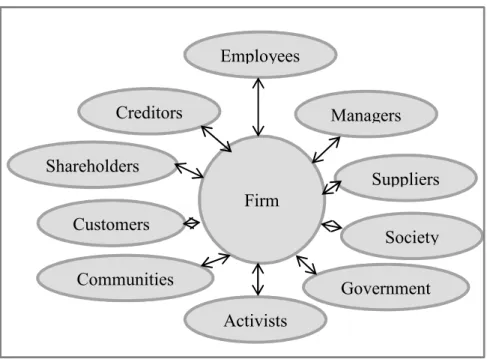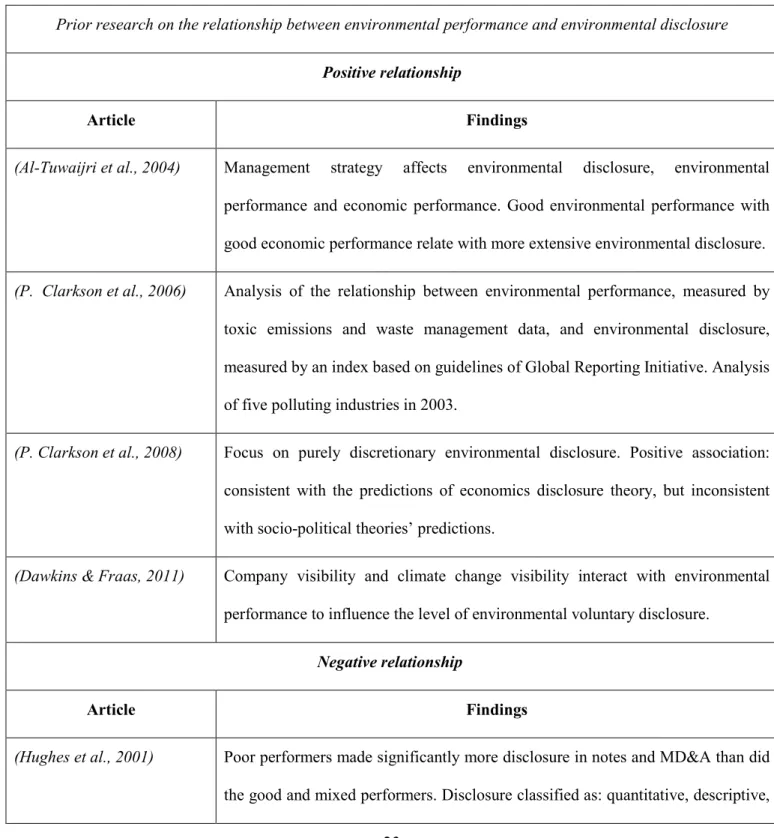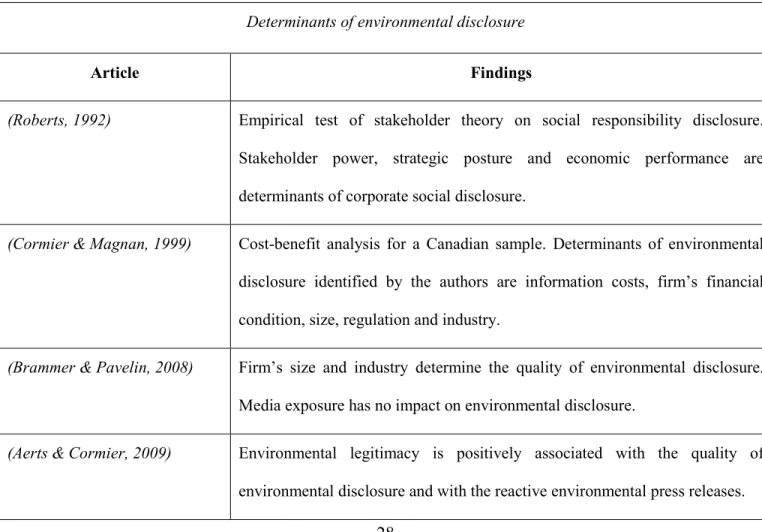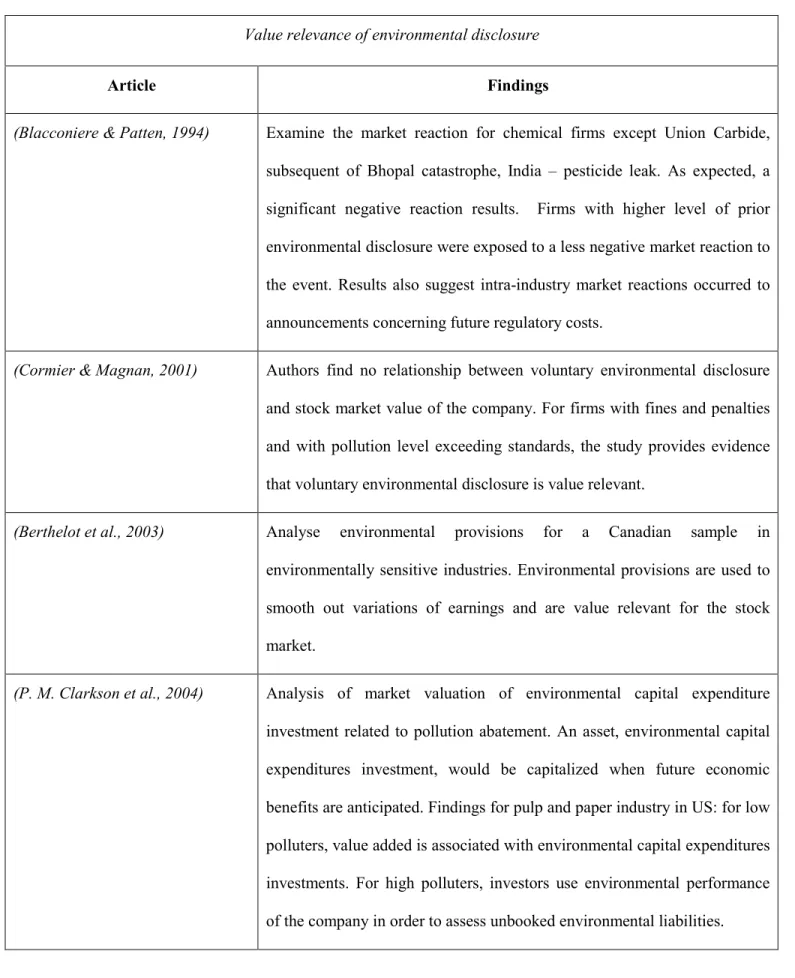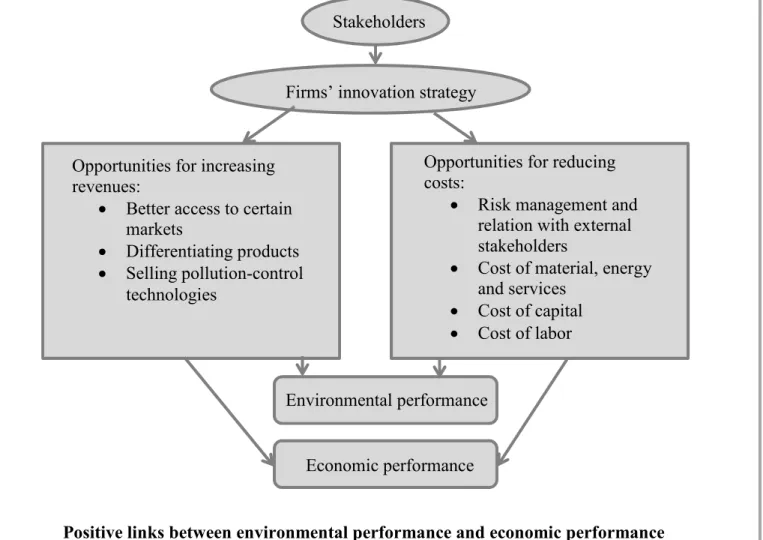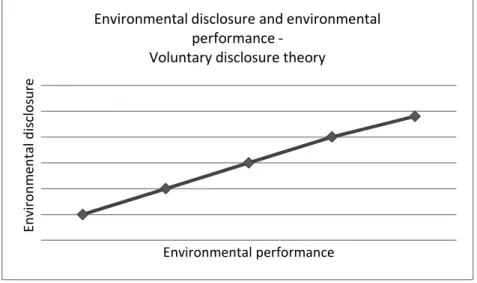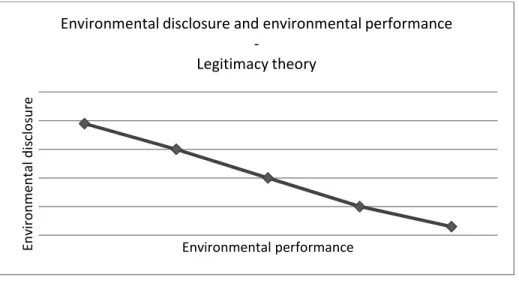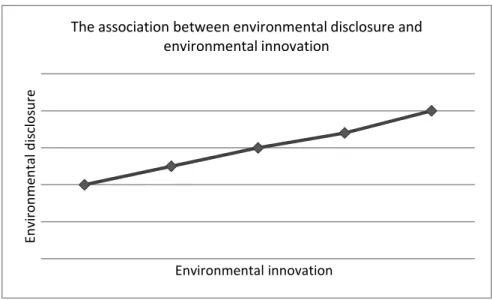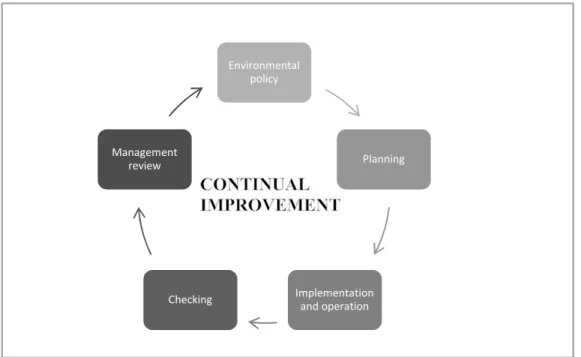HEC MONTRÉAL
École affiliée à l'Université de Montréal
What really drives environmental disclosure?
par Camélia Radu
Thèse présentée en vue de l’obtention du grade de Ph. D. en administration (option Sciences comptables)
Octobre 2015
HEC MONTRÉAL
École affiliée à l’Université de Montréal
Cette thèse intitulée :
What Really Drives Environmental Disclosure?
Présentée par :Camélia Radu
a été évaluée par un jury composé des personnes suivantes : Jacqueline Di Vito HEC Montréal Présidente- rapporteuse Claude Francoeur HEC Montréal Directeur de recherche Denis Cormier ESG-UQAM Membre du jury Yves Mard Université d’Auvergne Examinateur externe Martin Boyer HEC Montréal
Résumé
La responsabilité sociale est un sujet important dans le milieu des affaires et dans les médias à cause des pressions provenant des différentes parties prenantes. Le gouvernement, les investisseurs, les dirigeants et les administrateurs des entreprises, les organisations des industries, les environnementalistes et le milieu académique demandent une meilleure qualité de la communication environnementale des entreprises, ainsi qu’une meilleure évaluation de l’impact présent et futur de leurs activités sur l’environnement. Les recherches sur la fiabilité de la communication environnementale portent sur la relation entre la performance environnementale de l’entreprise et sa communication environnementale. Une communication environnementale fiable devrait refléter la performance environnementale réelle de l’entreprise, avec tous ses aspects. Tant qu’une relation positive qu’une relation négative entre la performance environnementale et la communication environnementale des entreprises ont été mises en évidence dans la littérature scientifique. Les entreprises qui ont une meilleure performance environnementale tendent à communiquer plus sur leurs réalisations que les autres entreprises. Par contre, les managers peuvent aussi utiliser la communication environnementale de leur entreprise comme un moyen de cacher une moins bonne performance environnementale.
La motivation de cette étude réside dans la demande accrue d’une communication environnementale fiable de la part d’une gamme élargie des parties prenantes. Cette recherche porte sur la fiabilité de la communication environnementale et analyse la relation entre la performance environnementale et la communication environnementale de l’entreprise, en considérant l’innovation environnementale comme un facteur important qu’influence cette relation. Par innovation environnementale, nous entendons la révision et la mise à jour du design des produits et des processus de production avec une focalisation sur la réduction ou l’élimination des inefficiences et la diminution des émissions et des déchets polluants.
vi
Sur un échantillon de 210 entreprises américaines, provenant des industries reconnues les plus polluantes, nous mettons en évidence le rôle modérateur joué par l’innovation environnementale. Nos résultats nous portent à croire que le niveau de divulgation environnementale est associé à la performance environnementale, mais l’amplitude de la divulgation diffère selon que l’entreprise est innovante ou non en matière d’environnement. Les entreprises non innovatrices ont tendance à divulguer significativement plus lorsque leur performance environnementale augmente. Nous observons l’effet contraire pour les entreprises innovantes. De façon générale, ces entreprises ont tendance à divulguer significativement plus que les entreprises non innovantes. Mais, cet écart tend à se résorber au fur et à mesure que leur performance environnementale s’accroît. Nos résultats empiriques montrent que cet écart est totalement résorbé lorsque la performance environnementale atteint un certain niveau. Pour les firmes innovantes, il semblerait y avoir un effet de substitution des déterminants de la divulgation environnementale. À bas de niveau de performance, les firmes innovantes divulguent leur stratégie d’innovation et leur plan d’action pour est plus performant en matière d’environnement. Lorsqu’ils deviennent performants, le contenu de leur divulgation est plus centré sur les éléments de performance.
Cette étude surligne le rôle important de l’innovation environnementale par rapport à la communication environnementale d’une entreprise. Les résultats de cette recherche pourront être utilisés par les législateurs et les organismes de régulation pour encourager les entreprises à trouver des solutions innovatrices dans le but de réduire l’impact de leurs activités sur l’environnement. Une réglementation qui favoriserait l’innovation environnementale devrait conduire à un plus haut niveau de développement durable. Les entreprises qui adoptent des stratégies environnementales proactives et innovatrices seront capables de réviser et restructurer leurs processus technologiques, réduire le niveau d’inefficiences et de retombées polluantes Cette recherche contribuera à une meilleure compréhension par les acteurs corporatifs et le public du rôle important joué par l’innovation environnementale dans la stratégie de communication environnementale de l’entreprise.
vii
Mots clés: communication environnementale, performance environnementale, innovation environnementale, fiabilité de la communication environnementale.
viii Abstract
Sustainability is a hot topic in business and the media due to increasing pressure from different stakeholders. Governments, investors, managers, industry organizations, environmentalists, and academics require better disclosure of firm environmental performance and better evaluation of actual and future environmental impact. The accuracy or reliability of environmental disclosure has been investigated by examining the relationship between environmental performance and environmental disclosure. Accurate or reliable environmental disclosure should reveal an organization’s true environmental performance. Both a positive and a negative association between environmental performance and environmental disclosure have been noted in the literature. Firms with better environmental performance tend to disclose more about their good performance than other types of firms. But, it has also been argued that managers may use environmental disclosure as a legitimizing tool to conceal their bad environmental performance.
This study is motivated by the growing need for reliable environmental disclosure from a wide range of interested stakeholders. It analyzes the reliability of environmental disclosure by examining the relationship between environmental performance and environmental disclosure and considers environmental innovation as an important factor that influences this relationship and explains environmental disclosure. Environmental innovation implies reviewing and updating product design and the production process with a focus on reducing inefficiency and lowering waste.
Using a sample of 210 US firms from environmentally sensitive industries in 2011, we find empirical evidence of the moderating role played by environmental innovation. Results show that the level of environmental disclosure is positively associated with environmental performance, and also with environmental innovation. Firms with no environmental innovation tend to disclose more when their
ix
environmental performance is better, contrary to environmental innovative firms. Generally, environmental innovative firms disclose significantly more than non-innovative firms, but the disclosure gap tends to be mitigated as their environmental performance increases. Empirical results show that the gap is completely absorbed when environmental performance reaches a certain high level. For environmental innovative firms, it seems to be a substitution effect of determinants of environmental disclosure. At low level of environmental performance, environmental innovative firms disclose more about their innovative strategy and action plan to become a better environmental performer. When they become good performers, environmental disclosure is more focused on performance elements. This study contributes to a better understanding of firms’ environmental disclosure.
Keywords: Environmental disclosure, environmental performance, environmental innovation, reliability of environmental disclosure.
x
Contents
Résumé ... v
Abstract ... viii
Contents ... x
List of tables ... xiii
List of figures ... xiv
List of Acronyms ... xvi
Acknowledgements ... xviii
Introduction ... 1
Chapter I. Literature review of environmental disclosure and environmental innovation ... 5
1.1. Theoretical framework development of environmental disclosure ... 5
1.1.1. Economic theories ... 6
1.1.2. Sociopolitical theories ... 8
1.2. Theoretical framework of environmental innovation ... 12
1.3. Empirical studies ... 14
1.3.1. Environmental disclosure evolution and measurements ...14
1.3.2. Empirical literature on environmental innovation ...19
1.3.3. Environmental disclosure reliability ...20
1.3.4. Determinants of environmental disclosure ...25
xi
1.3.6. Relationship between environmental performance and financial performance ...32
1.4. Related studies from the non-accounting literature ... 34
1.5. Regulatory framework ... 38
1.6. Radical/critical literature ... 42
Chapter II. Hypothesis development ... 44
2.1. Hypothesis development ... 45
2.2. Conceptual model ... 51
Chapter III. Methodology ... 54
3.1. Sample selection ... 54 3.2. Moderation effect ... 56 3.3. Regression model ... 57 3.4. Variables ... 60 3.4.1. Dependent variable ...60 3.4.2. Variables of interest ...61 3.4.3. Control variables...64
Chapter IV: Results and analysis ... 67
4.1. Descriptive statistics and correlations ... 67
4.2. Multivariate analysis ... 74
4.3. Sensitivity analysis ... 80
Chapter V: Discussion and conclusion ... 83
xii
5.2. Contribution, limitations and research opportunities ... 85
References ... 87
Appendix A: International standard ISO 14001 (actually in review) ... 98
Appendix B: Environmental disclosure grid ... 100
Appendix C: Example of collected environmental disclosure score ... 103
Appendix D: Environmental indicators – Sustainalytics ... 106
xiii List of tables
Table 1-1 - Prior research on development of methods to measure the environmental disclosure
and their results ... 16
Table 1-2: Results of prior research on the relationship between environmental performance and environmental disclosure ... 23
Table 1-3: Results of prior research on determinants of environmental disclosure ... 28
Table 1-4: Results of prior research on value relevance of environmental disclosure ... 31
Table 3- 1: Variables measurement ... 66
Table 4- 1: Sample industry composition ... 67
Table 4- 2 : Descriptive statistics ... 68
Table 4- 3: Descriptive statistics by environmental innovation ... 71
Table 4- 4: Correlations matrix ... 73
Table 4- 5: Results of regression analysis for hypothesis H1a and H1b ... 74
Table 4- 6: Results of regression analysis for hypothesis H2 ... 75
Table 4- 7: Results of regression analysis for hypothesis H3 ... 77
Table 4- 8: Results of sensitivity analysis for hypothesis H1a and H1b ... 80
Table 4- 9: Results of sensitivity analysis for hypothesis H2 ... 81
xiv List of figures
Figure 1-1: Model of a firm in agency theory (M. Jensen & W. Meckling, 1976) ... 7
Figure 1-2: Model of a firm in stakeholder theory ... 9
Figure 1-3: Positive links between environmental performance and economic performance ... 37
Figure 2 1: The relationship between environmental performance and environmental disclosure -Voluntary disclosure theory ... 45
Figure 2- 2: The association between environmental performance and environmental disclosure- Legitimacy theory ... 46
Figure 2- 3: The graphic of the expected association between environmental innovation and environmental disclosure (H2) ... 48
Figure 2- 4: Environmental management system model for ISO14001 ... 50
Figure 2- 5: Moderating effect – an example ... 51
Figure 2- 6: The influence of environmental innovation on the association between environmental performance and environmental disclosure ... 52
Figure 3- 1: Moderator model ... 56
Figure 3- 2: The distribution of environmental patents in the sample ... 63
Figure 4- 1: Industry composition ... 68
Figure 4- 2: Environmental disclosure and environmental performance by industry ... 70
Figure 4- 3: Environmental innovation by industry ... 70
xv
Figure 4- 5: Mean of environmental performance by environmental innovation ... 72 Figure 4- 6: Graphs of environmental disclosure as function of environmental disclosure for firms with no environmental innovation versus environmental innovative firms ... 78 Figure 4- 7: Graph of interaction between environmental performance and environmental
xvi
List of Acronyms CSR – Corporate Social Disclosure
EMS – Environmental Management System
GRI - Global Reporting Initiative
IFRS - International Financial Reporting Standards
IPC - International Patent Classification
ISO – International Organization for Standardization
R&D – Research and Development
SD – Standard Deviation
TRI - Toxic Release Inventory
US GAAP - Generally Accepted Accounting Principles in the United States
VIF - Variance Inflation Factor
xvii
xviii
Acknowledgements
When I started my Ph D program my supervisor told me that I do not need to imagine it as climbing a big mountain. Now I look behind at this journey and it seems to me like having reached out for Everest's summit. And I did it, but I was not alone. This would have not been possible if not having the support of many individuals and organizations. Therefore I would like to extend my sincere gratitude to all of them.
First of all, I would like to express my deepest gratitude to my supervisor, Claude Francoeur, for invaluable constructive criticism, guidance and friendly advice during my doctoral studies.
I am also grateful to my committee members, Denis Cormier and Marie-Josée Ledoux, for their comments that greatly improved my thesis.
Nevertheless, I express my gratitude toward my family. First of all, I’m grateful to my mother and my father, who inspired me to pursue doctoral studies, to my brother, Viorel, who was my first reader and editor, to my daughter Aida and my son Felix and to my husband Silviu. Thank you for your love and support.
I am also immensely grateful to Paulina Arroyo for her comments on an earlier version of my thesis and to all my colleagues from UQAM for their encouragement to continue, when I had no inspiration or I was overwhelmed by my research project.
I would like to thank ‘Institut des vérificateurs internes de Montréal’, ‘Ordre des CGA du Québec’ and ‘HEC Montréal’ for their generous financial support.
Introduction
Pollution, climate change, and the preservation of life and health on our planet are subjects on agenda of increasing numbers of stakeholders, such as corporate management, employees, governments, investors, environmentalists, researchers, and analysts. Stakeholders are concerned about ethical performance and keeping the environment healthy for present and future generations. Consequently, corporate social responsibility (CSR), including environmental strategies, activities, and innovation, is being actively scrutinized. In reaction, more and more firms voluntarily disclose information about their environmental activities, performance, and impacts.
In spite of this growing interest in the corporate environment activities, pollution continues to increase and environmental incidents happen. This raises questions about the accuracy or reliability of environmental information disclosed by organizations. Is the environmental disclosure a true reflection of the firm’s environmental performance? Do firms use this channel mainly to legitimize their environmental actions? Does an efficient tool exist with which to appropriately discern the reliability of environmental information? What really drives environmental disclosure? This research strived to shed light on these questions by examining the reliability of corporate environmental disclosures. Environmental innovation is considered a key determinant of environmental disclosure.
Generally Accepted Accounting Principles in the United States (US GAAP) define verifiable and objective information as reliable. International Financial Reporting Standards (IFRS), in their 1989 framework, indicate
“Information has the quality of reliability when it is free from material error and bias and can be depended upon by users to represent faithfully that which it either purports to represent or could reasonably be expected to represent” 1989 IFRS Framework, para.31
2
The 2014 conceptual framework of IFRS uses the term faithful representation instead of the term reliability as one of fundamental qualitative characteristics of useful financial reporting. Information is reliable when is a faithful representation of a transaction, event or condition, reflecting the economic substance and not the legal form, complete, neutral and free from error. Other fundamental qualitative characteristics of financial reporting are relevance and materiality. Environmental disclosure should also present these characteristics to be useful to firm’s stakeholders for making decision.
The relationship between a firm’s environmental performance and environmental disclosure is an indicator of the reliability of its environmental disclosure. A reliable corporate environmental disclosure should therefore properly and fairly report a firm’s environmental performance.
Prior research on the relationship between environmental performance and environmental disclosure finds mixed evidence. A number of studies find evidence of a positive relationship: Al-Tuwaijri et al. (2004), P. Clarkson et al. (2006), Dawkins and Fraas (2011); other studies highlight a negative relationship: Hughes et al. (2001), Patten (2002), Charles Cho and Patten (2007), Cormier et al. (2011), while others find no association between environmental performance and environmental disclosure: Ingram and Frazier (1980), Wiseman (1982), Freedman and Wasley (1990), Fekrat et al. (1996). These disparate results could be caused by the fact that different methods were used to measure environmental disclosure and performance, the use of different samples from different industries that are more or less environmentally sensitive, and research conducted in countries with different environmental regulations. Omitted variables such as environmental innovation could also be a source of these discrepancies.
This research investigates competing predictions of the relationship between environmental performance and environmental disclosure from two different theoretical perspectives: economic voluntary disclosure theory and sociopolitical theories. We contend that environmental innovation plays an important role in this relationship. Environmental innovation interacts with environmental performance to determine
3
environmental disclosure. Environmental innovative firms have incentives to disclose more about their environmental innovations when they are poor environmental performers. They will tend to inform stakeholders about their innovation and strategies to become better environmental performers.
Environmental disclosure includes both voluntary and mandatory disclosure, such as that collected from the firm’s annual report (Form 10-K), sustainability report, CSR report, and other environmental information disclosed on the firm’s website, such as a sustainable development portal or a health, safety, security, and environment commitment.
Results confirm economic voluntary disclosure theory prediction of a positive association between environmental performance and environmental disclosure. The level of environmental disclosure is positively associated with environmental performance, but is also positively associated with environmental innovation. We find evidence of a significant moderating effect of environmental innovation on the association between environmental performance and environmental disclosure. Environmental innovative firms tend to disclose significantly more than non-innovative firms when both are considered poor environmental performers. Disclosure gap tends to be mitigated as their environmental performance increases. Empirical results show that this disclosure gap is completely absorbed when firms reach a certain level of environmental performance. For environmentally innovative firms, there seems to be a substitution effect. At low level of environmental performance, environmental innovative firms disclose more about their innovative strategy and action plan to become better environmental performer. When they become good environmental performers, environmental disclosure is more focused on performance.
These findings provide new evidence of the meaningful role played by environmental innovation in improving environmental disclosure.
4
This paper is structured as follows: Chapter I reviews the literature on environmental disclosure and environmental innovation, Chapter II describes the hypothesis development, and Chapter III provide details about the sample and the research method. Empirical findings are presented in Chapter IV, followed by a discussion and conclusion in Chapter V.
5
Chapter I. Literature review of environmental disclosure and environmental innovation
Social and environmental accounting deals with a wide range of voluntary and mandatory disclosures of the social and environmental activities of an organization that are designed to respond to stakeholders’ demands. The social and environmental accounting literature has a recent history, starting only in the 1970s. It includes research with a focus on employees, products and activities that concern local communities, society and customers. But, the main focus has been on environmental accounting. This research specifically investigates environmental disclosure and its presumed link with environmental performance.
Literature on environmental innovation is scarce. Research considers mainly general innovations instead of specific environmental innovation. The link of environmental innovation with environmental disclosure is not enough studied.
In this section we will first review the main theoretical framework and empirical studies on environmental disclosure and environmental innovation. We will then cover related studies from non-accounting literature and the regulatory framework surrounding environmental disclosure. The last section will be dedicated to radical/critical literature.
1.1. Theoretical framework development of environmental disclosure
One of the first contributors to the theoretical development of environmental accounting was Ramanathan (1976). This study has set up objectives and clarified key concepts for social accounting. Also in 1976, A. E. Ullmann (1976) developed a corporate environmental accounting model that includes non-financial and physical measures of environmental inputs and outputs. With the purpose of
6
measuring and reporting the economic activities that affect society, Ullmann criticizes the monetary input approaches used in environmental accounting. The weakness of these CSR financial costs approaches is that they do not reflect the efficiency or the adequacy of the money spent. Ullmann’s model measures financial costs and nonmonetary environmental effects of economic activities, including discharge of pollutants in air, water and soil and consumption of resources, as materials and energy.
Environmental disclosure can be used to signal good environmental performance, but, in the case of poorer performance, it also can be used as a legitimacy tool. Two competing theories, economic and sociopolitical, explain these two determinants of environmental disclosure. However, as Gray et al. (1995) indicate, the use of different theoretical perspectives to explain environmental disclosure does not imply a competition between explanations. These theories complete each other and enrich our comprehension of environmental disclosure.
1.1.1. Economic theories
Economic theories model environmental disclosure as a tool to signal good environmental performance. Voluntary disclosure theory derives from agency theory applied to environmental disclosure.
Agency theory
A permanent asymmetry of information exists between principals and shareholders and between agents and managers. M. C. Jensen and W. H. Meckling (1976) define the agency relationship as a contract under which the principal engages the agent to perform some service on its behalf, which involves delegating some decision making authority to the agent. This contractual relationship creates information asymmetry between the principal and the agent because their interests diverge.
Figure 1-1 presents the model of a firm derived from the agency theory. Agency theory considers that firm value is diminished by the underlying cost of the agency relationship, that is, the principal’s
7
monitoring expenditures, the agent’s bonding expenditures, and the residual loss, a reduction in the principal’s welfare. And, this cost varies across firms.
Voluntary disclosure theory
According to Lev (1992) a voluntary information disclosure strategy contributes to narrowing the information gap between investors and management and decreases agency costs. A firm’s voluntary disclosure strategy can increase a firm’s value in terms of reduced cost of capital and improved terms of trade and covenants by changing the stakeholders’ perceptions about the firm and its market value.
Voluntary disclosure theory posits that firms with good environmental performance have incentives to send a signal to the market about their good performance through voluntary disclosure and to increase their firm valuation. Bad performers will take profit from remaining silent and being considered by the stakeholders as average performers (P. Clarkson et al., 2008). Li et al. (1997) and Bewley and Li (2000) find that firms with good environmental performance have incentives to inform investors and stakeholders about their performance by providing extensive voluntary environmental disclosure. Bad performers refrain from disclosing information about their environmental performance, arguing that
Principal Agent
Information asymmetry Hires
Performs AGENCY COSTS
8
disclosure implies costs. Verrecchia’s model (1983) shows indeed that disclosure-related costs explain managerial discretion in the disclosure of information. Managers can also choose to selectively disclose good information and suppress bad information (Dye, 1985).
Agency theory can be generalized to stakeholders, including employees, customers, suppliers, creditors, governments, communities, industry associations, and the general public (Hill & Jones, 1992). The relationship between managers and shareholders is seen as a nexus of contract, but it could be extended to include other contracts between stakeholders and managers. Economics-based voluntary disclosure theory predicts a positive association between environmental performance and environmental disclosure (P. Clarkson et al., 2008). Good environmental performers have incentives to disclose more about their good environmental performance through voluntary environmental disclosure. Voluntary environmental disclosure is value relevant for stakeholders and leads to increased firm valuation.
Lyon and Maxwell (2011) consider as environmental greenwash the selective disclosure of positive information while withholding negative information about environmental performance. They develop an economic model of greenwash and conclude that greater activist pressure discourages greenwash and triggers less environmental disclosure.
1.1.2. Sociopolitical theories
Sociopolitical theories explain the use of environmental disclosure from the perspective of stakeholder theory, institutional and legitimacy theory.
9 Stakeholder theory
A stakeholder in an organization is defined by Freeman (1984) as any group or individual who can affect or is affected by the achievement of the organization’s objectives. The model of the firm under the stakeholder theory is presented in Figure 1-2.
Stakeholders include shareholders, employees, customers, suppliers, creditors, governments, communities, activists, industry associations, the media, and the general public. Stakeholder attributes identified by Mitchell et al. (1997) are power (control of material, financial, or symbolic resources), legitimacy (desirable social good), and urgency (imperative, criticality). These attributes are not fixed and evolve over time (Magness, 2008).
Stakeholder pressure typically triggers two types of behavior. Reactive stakeholder management looks at past activities and at lessons learned from the past. They will minimize or avoid past weaknesses or problems and will solve them differently in the future. Proactive stakeholder management look forward
Firm Employees Managers Suppliers Society Government Customers Shareholders Creditors Communities Activists
10
to future activities and adapt their actions to changing environments, to obtain a better cooperation between firms and stakeholders (Smudde & Courtright, 2011).
Based on conflicting external demands received by a firm, stakeholder theory explains the corporations’ engagement in CSR activities1 (Freeman, 2004), including environmental disclosure. A. A. Ullmann (1985) analyzes the level of power of different stakeholders’ to control organization resources. Organizations selectively respond to stakeholder requirements as a function of their relative power. Stakeholder power tends to be positively correlated with the organization’s social performance when stakeholders control its critical resources. The organization will tend to ignore stakeholder demands when their power is weak.
Institutional and legitimacy theory
Institutional theory, seen by Scott (2013) as a widely accepted theory focuses on rational myths, isomorphism, and legitimacy. Rational myths such as legal environments (law firms and regulators) play an important role in organization (Suchman & Edelman, 1996). Rule and belief systems are used to increase legitimacy. Isomorphism is a similarity between organizations, as a result of mimic process or reproduction under similar conditions (DiMaggio & Powell, 1983). Legitimacy, as defined by Suchman (1995), is a generalized perception or assumption that the actions of an entity are desirable, proper or appropriate within some socially constructed system of norms, values, beliefs, and definitions. As a sociopolitical theory, legitimacy theory sees environmental and social disclosure as a measure of an entity’s environmental and social responsibility. A hypothetical social contract exists between the company and society (Mathews, 1993). Firm responsibilities go beyond financial performance demanded by shareholders, including social and environmental performance in response to their demands. Neu, Warsame, and Pedwell (1998) define the relevant public of environmental disclosure as
1
11
the financial stakeholders, such as shareholders and creditors, and regulators, such as the government. The secondary public for environmental disclosure consists of environmentalists.
Legitimacy is identification with values, symbols, and practices accepted by society, to demonstrate congruence between organizational practices and the values of the social environment (Solomon & Lewis, 2002). Perceptions held by the relevant public and by society play a central role in legitimacy theory. Environmental disclosure can then be used as a tool to change stakeholder perceptions, to legitimize a firm’s activities as acceptable, and to conform to stakeholders’ values, symbols, and methods. Firm’s credibility and industry legitimacy are factors with a significant impact on perceived environmental legitimacy (Cormier & Aerts, 2009).
Stakeholder expectations concerning environmental performance increase over time and poor environmental performance threatens firm legitimacy. Environmental disclosure, used as a tool to change stakeholder perceptions, legitimizes a firm’s environmental activities. A negative relationship between environmental performance and voluntary environmental disclosure is predicted by socio-politically based legitimacy theory. Gray et al. (1995) find that firms with poor environmental performance have incentives to disclose more.
Organizations use either social/environmental performance or social/environmental disclosure or both as a tool to manage their relationships with stakeholders. Cormier et al. (2011) recently studied the effect of substitution versus complementary role of environmental and social disclosure in reducing information asymmetry between managers and stock market participants. Environmental disclosure and social disclosure substitute for each other in reducing information asymmetry; consequently, their total effect on information asymmetry is not the addition of their separate effects. Hence social disclosure strengthens the informativeness of environmental disclosure for investors.
12
In conclusion, we do not have an integrated theoretical framework to describe and predict the level or effects of environmental disclosure. Several overlapping theories are employed to explain different aspects of environmental disclosure, but there is room for development.
1.2. Theoretical framework of environmental innovation
Rennings (2000) defines environmental innovations as the actions of a firm’s relevant actors that (i) develop new ideas, behavior, products and processes, apply or introduce them, and(ii) contribute to a reduction of environmental burdens or to ecologically specified sustainability targets. According to R. Kemp et al. (2001), environmental innovation consists of creating or modifying processes, techniques, systems and products to better protect the environment. A distinction should be made between incremental and radical innovation. Incremental innovations are minor changes of existing product or processes, while radical innovation arises from technological discontinuity, an important technological or process advance.
Theoretical framework of environmental innovation derives from theories for general innovations and is improved by environmentally specific factors as institutional or political factors.
Innovation theories focus on the relevance of technology push, demand pull or market factors (Horbach, 2008).
Technology push
Scientific field has a strong influence on innovation (Nemet, 2009). New environmental technology pushes a firm to innovate and obtain a better position on the market and an increased competitiveness (Less & Araya, 2008). Environmental innovation can be considered as investments in knowledge capital
13
(Smolny, 2003). This knowledge capital induces future innovation, hence innovation triggers innovation. Technology push theory on innovation ignores innovation’s profitability (Nemet, 2009).
Market structure has an influence on innovation. Monopolistic market structures encourage large firms to innovate; these firms will be less exposed to competitor’s imitation. Scale economies generated by innovation will be more important in this case. Small firms in competitive market try to demarcate from competitors by developing new products. In conclusion, the effect of firm’s size on environmental innovation is still unclear (Smolny, 2003).
Demand pull
Technology push factors are more relevant in initial phase of developing a new product. In diffusion phase, demand from stakeholders (consumers, social responsible investors, government, industry, society etc.) pulls innovation (Less & Araya, 2008). Variation in demand drives innovation; increase in demand will determine more investments in innovation to satisfy unmet needs (Nemet, 2009).
Institutional and political factors
Environmental innovation are driven by environmental policy (Porter & van der Linde, 1999). Environmental regulation, fiscal system, international protocols or peers agreements are incentives to environmental innovation (Ozusaglam, 2013). On the other side, René Kemp and Pontoglio (2011) conclude that the link between regulator and regulated is not unidirectional and that multiple policies affect innovation.
14 1.3. Empirical studies
In this sub-section we will present the development of the methods to measure environmental disclosure and environmental innovation and the main studies on environmental disclosure’s evolution, reliability, determinants and value relevance.
1.3.1. Environmental disclosure evolution and measurements
In the early stages of environmental accounting research, empirical studies focused on the development of methods to measure the incidence of environmental disclosure. Table 1-1 presents the main papers on the development and the results of such methods.
As the literature shows, measurement methods evolved over time, starting from a simple yes/no analysis of the presence of social/environmental disclosure in annual reports (Ernst & Ernst, 1978), followed by quantitative measures of the volume of environmental disclosure (Wiseman, 1982), to complex scores based on both the quantity and quality of environmental disclosure (Cormier & Magnan, 2003); (Aerts et al., 2006). Based on an index including quantitative and qualitative measures, Wiseman (1982) concludes that environmental disclosure is incomplete and does not adequately reflect organization’s environmental performance.
Later, Gibson and O'Donovan (2007) use content analysis of environmental disclosure in Australia from 1983 to 2003 and note an increased volume of environmental disclosure over time. Findings for Australian firms using sentence or pages counts show an increased level of the media besides annual reports used for environmental disclosure, such as separate environmental reports (Tilt, 2008). Brammer and Pavelin (2008) employing content analysis examine the quality of environmental disclosure of UK companies and find that firm size and industry are important factors influencing environmental disclosure.
15
Tagesson et al. (2009) study, using an index, social disclosure in Swedish municipalities and the factors that explain its extent and content. Organization size, its tax base and tax rate, financial performance, and the political majority drive the extent of social disclosure, including environmental disclosure.
Alternative methods for analyzing environmental disclosure are proposed by C. Cho et al. (2010). Their measure of the language and verbal tone used in environmental disclosure is based on two dimensions: “optimism,” viewed as a language supporting particular groups, concepts, or events that presents the performance positively, and “certainty,” which refers to the inflexibility and completeness of the disclosure. Using content analysis, the authors find evidence that worse environmental performers use more optimism and less certainty in their disclosures than better environmental performers do, as a tool for managing stakeholder impressions.
Delmas and Blass (2010) examine the possible trade-offs of different environmental performance evaluation methods. Sustainability ratings used by socially responsible investors in their decision process reflect a trade-off between a focus on penalties for poor performers and a focus on rewards for good performers. Other possible trade-offs the authors identify are those between activities and processes with a direct and immediate environmental impact versus less directly activities and processes or those with no current impact; the trade-off between reporting and management practices as a proxy for future performance at the expense of presenting current performance; and the trade-off between the choices of different measures based on data availability.
Focusing on environmental capital expenditures as a measure of mandatory environmental disclosure, Charles Cho et al. (2012) find that environmental capital expenditures amounts are mostly immaterial, with worse polluters disclosing more immaterial amounts. The lack of materiality could be an explanation for non-disclosing firms.
16
Analyzing the quality of environmental disclosure using a disclosure index derived from Global Reporting Initiative framework, Rupley et al. (2012) note an increase in environmental disclosure quality over time. They find a positive association between voluntary environmental disclosure and environmental media coverage and negative environmental media as a proxy for firm’s environmental legitimacy. Board attributes of independence, diversity, and expertise are positively associated with voluntary environmental disclosure, suggesting that good governance is associated with firm transparency.
In conclusion, the measures used in environmental disclosure research evolve with time and forms of disclosure, from quantitative measurements to qualitative and quantitative evaluations. Moreover, we note the introduction of different forms of environmental disclosure, such as stand-alone environmental reports, environmental information published on the Web, and mandatory disclosure in 10-K forms. Present measurement methods in environmental disclosure, based on scores or indexes, contingent on measurement error, subjectivism, or the cost and availability of data, can be improved. Even if the actual measurement is not perfect, research can help stakeholders better evaluate a firm’s environmental disclosure or pressure the government and legislators to regulate environmental disclosure.
Table 1-1 - Prior research on development of methods to measure the environmental disclosure and their results
Development of methods to measure the environmental disclosure and their results
Article Findings
(Ernst & Ernst, 1978) Survey on social responsibility disclosure of Fortune 500 annual reports. Social responsibility disclosure types identified: environment, energy, fair business
practice, human resources, community involvement and products.
(Wiseman, 1982) Examine the quality and the reliability of environmental disclosure in annual reports using an index to measure the content of disclosure. Conclusion:
17
corporate environmental disclosure is not related to environmental performance.
(Cormier & Magnan, 2003) A synthesis of environmental disclosure research: voluntary disclosure, external disclosure and mandatory disclosure. Sixty papers reviewed and grouped by:
reliability of disclosure, value relevance or determinants of environmental
disclosure.
(Aerts et al., 2006) An analysis of intra-industry imitation in corporate environmental reporting for a sample from Canada, France and Germany over a six-year period. Mimetic
behaviors are generated by high quality reporting and the mimetic process is
enhanced in highly concentrated industries.
(Gibson & O'Donovan, 2007) The volume of environmental disclosure in an Australian context increased over the period analysed: 1983-2003, as result of new government policy and
standards, changes in legislation, or best practice recommendations for the
sector.
(Tilt, 2008) Examine the use of environmental disclosure outside the annual report in Australian companies from 1994 to 1999. The use of stand-alone environmental
reports increased and the use of other type of environmental disclosure
diminished.
(Brammer & Pavelin, 2008) Find as determinants of the quality of environmental disclosure for a sample of 450 UK companies: firm and industry characteristics. High quality disclosure is
associated with larger firms and with firms from environmental-sensitive
industries.
(Tagesson et al., 2009) Study of the extent and variation of content in social disclosures, including human resources, ethics and environmental disclosure, in annual reports and
official statistics of Swedish municipalities. Findings: significant differences
between municipalities concerning the volume and the content of social
18
tax rate, financial performance and political majority of the municipality.
(C. Cho et al., 2010) Content analysis of environmental disclosure to determine if the language and tone of environmental disclosure are used as a tool for managing public
impressions. They find that worse environmental performers use more
«optimism» and less «certainty» in their environmental disclosure than better
performers.
(Delmas & Blass, 2010) Analysis of trade-offs existent in the evaluation of environmental and social performance. There are differences in the evaluation when the measure is based
on toxic releases and regulatory compliance or on the quality of environmental
policy and disclosure. Firms with the most advanced environmental disclosure
and environmental management practices are likely to have higher levels of
toxic releases and lower environmental compliance, so worse environmental
performance.
(Charles Cho et al., 2012) Examine, for a US sample, if disclosure of environmental capital expenditures is a function of materiality of spending. They find that the disclosed amounts of
environmental capital expenditures are not material, for the majority of 119 US
companies analysed, suggesting that non-disclosure is determined by
immateriality. The choice to disclose is associated with worse environmental
performance.
(Rupley et al., 2012) Examine the relationship between governance and media coverage and the quality of voluntary environmental disclosure, on a sample of 416 US firms,
from 2000 to 2005. They conclude that there is a positive association between
the quality of voluntary environmental disclosure and environmental media
coverage, negative environmental media and some characteristics of governance:
the independence, diversity and expertise of the board. They also find an
19
1.3.2. Empirical literature on environmental innovation
The empirical literature on environmental innovation is scarce. Jaffe and Palmer (1997) and Brunnermeier and Cohen (2003) examine the impact of pollution abatement expenditures on innovative activity. They conclude that research and development expenditures and patents induce innovation. Carrión-Flores and Innes (2010) find evidence of bidirectional causal links between the number of environmental patents as a proxy for environmental innovation and toxic air pollution as a proxy for environmental performance. In conclusion, environmental innovation plays an important role on firm’s environmental performance.
Jaffe and Palmer (1997) test the relationship between environmental regulation and innovation, using two measures of innovation, R&D expenditures and successful patent application, in relationship to compliance expenditures. They conclude that, within an industry, increases in compliance expenditures are related to increases in R&D shortly thereafter, hence environmental regulation will stimulate innovation.
Wagner (2007) investigates, in a German context, the relationship between environmental management, environmental innovation, and patents. The author concludes that patent data is a better measure of environmental innovation than self-reported environmental innovation. According to this study, the implementation of environmental management systems has a positive effect on environmental process innovation. Wagner (2009) also explores the relationship between environmental management systems and environmental innovation in an international context and finds evidence of an relationship between environmental management systems and process innovations, moderated by the interaction between environmental management systems and a country’s culture and regulatory regime. Lower flexibility of regulatory policy, as prescribing specific technologies for specific environmental performance targets,
20
has a negative effect on process innovation. Environmental management system implantation has an effect on innovation only for Netherlands, Germany, Norway, Sweden and UK, countries with strong environmental policies.
Brunnermeier and Cohen (2003) analyze the determinants of environmental innovation. They find that regulators’ increased monitoring and enforcement activities do not provide additional incentives to innovate. Horbach (2008) also explores the determinants of environmental innovation and suggests the importance of improvements in technological capabilities by R&D, increase in future demand, and historical innovative orientation. Other relevant determinants are environmental regulation, environmental management systems, and organizational changes. H. Hammar and S. Löfgren (2010) find evidence that R&D expenditures related to environmental protection are a determinant of clean technology adoption through internal learning, that is, learning by searching.
1.3.3. Environmental disclosure reliability
A large number of empirical studies examine the reliability of environmental disclosure. The definition of reliability in the Accounting and Financial Management Dictionary2 is a “Qualitative characteristic of the information published in financial statements, such that users can trust that the presentation of operations and underlying events is consistent with the facts and reasonably free of error and bias.”
This definition can be extended to environmental disclosure, as a form of information published in financial statements or stand-alone reports, such as sustainability, corporate responsibility, citizenship, and other corporate reports. The IFRS conceptual framework uses the term faithful representation instead of reliability for financial reporting. Accordingly, environmental disclosure should be a faithful representation of a firm’s environmental performance. Environmental disclosure accuracy or reliability
2
21
is empirically examined by looking at the association between organizational environmental disclosure and environmental performance. Table 1-2 presents a summary of the findings of prior research on this subject.
Prior empirical research finds contradictory results about the relationship between environmental disclosure and environmental performance. A positive association is noted by Al-Tuwaijri et al. (2004), P. Clarkson et al. (2006), P. Clarkson et al. (2008), and Dawkins and Fraas (2011). For their part, Hughes et al. (2001), Patten (2002), C. Cho and Patten (2007), P. Clarkson et al. (2011), and D. Cormier et al. (2011) find a negative relationship. Finally, Ingram and Frazier (1980), Wiseman (1982), Freedman and Wasley (1990), and Fekrat et al. (1996) do not find any significant relationship between these variables.
Possible explanations for the mixed empirical results are the different measures employed for environmental disclosure or performance (P. Clarkson et al., 2006; Patten, 2005) or the application of different theoretical perspectives, such as economic or sociopolitical theories of voluntary disclosure (P. Clarkson et al., 2008). According to Fekrat et al. (1996) there could be a combined industry and regulation effect. P. Clarkson et al. (2011) underline the difference between “hard” and “soft” environmental disclosure, hard disclosure being based on objective and verifiable items and soft disclosure on more subjective items. Quantitative methods do not measure soft disclosure adequately. Different results could be obtained using qualitative measurements.
Another possible explanation for these mixed results is the influence of disclosure strategy on environmental disclosure (P. Clarkson et al., 2011) or an interaction between environmental performance and media or climate change visibility (Dawkins & Fraas, 2011). Firms are less likely to provide environmental disclosure when media or climate change visibility is lower. The authors highlight the potential for other factors to interact with environmental performance to influence
22
environmental disclosure. Bouten et al. (2012) consider that the operationalization of the dependent variable and the choice of method could also be a reason for inconsistent results. The level of social and environmental disclosure is typically set to zero for non-disclosing firms and that may triggers the choice of an inappropriate estimation method, with effects on empirical findings. Hence, they limit their sample only on disclosing firms, excluding non-disclosing firms to avoid setting the environmental disclosure to zero for them.
Guidry and Patten (2012) review 13 environmental disclosure studies and analyze the use of financial control variables based on voluntary disclosure theory. They admit an important limitation of their study: the lack of comparability of disclosure measures used. This lack of comparability could also be an explanation for prior empirical mixed results. Concerning control variables they conclude that, at the exception of firm size, the exclusion of financial control variables based on voluntary disclosure theory does not lead to incorrect inferences on the relationship between environmental performance and environmental disclosure. Financial control variables are deemed to be associated with financial disclosure, viewed as a tool to reduce information asymmetry between managers and investors. Using legitimacy theory, voluntary environmental disclosure represents a tool to legitimate environmental activities and differs from financial disclosure representation. In conclusion, the authors failed to find evidence of systemic association between financial control variables and voluntary environmental disclosure.
Rupley et al. (2012) use longitudinal analysis and find evidence of an increase in environmental disclosure quality over time, from 2000 to 2005. This result could also explain the disparity of previous empirical studies, because the general picture of environmental disclosure evolved over time. Combs et al. (2011) explain that variables and relationships between variables describing social phenomena are historically dependent and may vary over time. The variability of empirical results could also be explained by misspecified models with important omitted variables (e.g. firm’s level of environmental
23
innovation) or to the lack of consideration of moderating effects (Dawkins & Fraas, 2011). We consider environmental innovation as an important determinant of environmental disclosure, in addition to environmental performance. This subject is developed further in Chapter II.
Table 1-2: Results of prior research on the relationship between environmental performance and environmental disclosure
Prior research on the relationship between environmental performance and environmental disclosure
Positive relationship
Article Findings
(Al-Tuwaijri et al., 2004) Management strategy affects environmental disclosure, environmental performance and economic performance. Good environmental performance with
good economic performance relate with more extensive environmental disclosure.
(P. Clarkson et al., 2006) Analysis of the relationship between environmental performance, measured by toxic emissions and waste management data, and environmental disclosure,
measured by an index based on guidelines of Global Reporting Initiative. Analysis
of five polluting industries in 2003.
(P. Clarkson et al., 2008) Focus on purely discretionary environmental disclosure. Positive association: consistent with the predictions of economics disclosure theory, but inconsistent
with socio-political theories’ predictions.
(Dawkins & Fraas, 2011) Company visibility and climate change visibility interact with environmental performance to influence the level of environmental voluntary disclosure.
Negative relationship
Article Findings
(Hughes et al., 2001) Poor performers made significantly more disclosure in notes and MD&A than did the good and mixed performers. Disclosure classified as: quantitative, descriptive,
24 vague, and immaterial.
(Patten, 2002) Companies with worse environmental performance include more extensive environmental disclosures in their 10-K reports. Worse environmental
performance means higher levels of size-adjusted toxic releases.
(C. Cho & Patten, 2007) Companies use environmental disclosure as a tool to mitigate the potential negative impact of actual performance information.
(P. Clarkson et al., 2011) Results contradictory to (P. Clarkson et al., 2008): Higher polluters disclose more. Measure based on GRI disclosure index in an Australian context.
(Cormier et al., 2011) Results on determinants of environmental disclosure show that environmental performance is an important determinant of CSR disclosure. Evidence of a
negative relationship between environmental performance and CSR disclosure.
No relationship
Article Findings
(Ingram & Frazier, 1980) Environmental disclosure in annual report is not significantly related with CEP index of environmental performance.
(Wiseman, 1982) The volume of environmental disclosure is not representative of its quality and voluntary disclosure is incomplete and provides only general information about
environmental performance of a company. Index criticised: focus on quantitative
disclosure rather than qualitative.
(Freedman & Wasley, 1990) Environmental disclosure in annual and 10-K reports is not related with environmental performance indices as published by the Council of Economic
Priorities.
(Fekrat et al., 1996) Environmental disclosure in annual reports is not associated with environmental performance. There are significant differences concerning environmental
25
disclosure between industries and countries. 18 countries and 6 industries were
analysed.
1.3.4. Determinants of environmental disclosure
A summary of past research on the determinants of environmental disclosure is presented in Table 1-3. To test stakeholder theory in the context of social responsibility disclosure, Roberts (1992) uses a sample of 80 Fortune 500 companies. Stakeholder power—including the potential stakeholder power of passive investors, governmental risks, and potential creditors is shown to be a function of the stakeholder’s degree of control over resources used by the firm. This author finds evidence of a positive association between stakeholder power or demands and the level of social responsibility disclosure. The strategy of a firm determines the response to stakeholder’s social demands. The presence of a philanthropic foundation is an indicator of a corporate strategic plan to make charitable contributions as a tool to manage stakeholders’ demands. Firms with corporate public affairs departments and with contribution to charity reflect an active strategic posture seen as a positive attitude toward social responsibility activities. The active strategic posture is translated into greater social responsibility activities (Roberts, 1992).
Economic performance, measured by either an accounting-based measure (return on equity) or a stock market-based measure (systematic risk), also determines the level of social responsibility disclosure. Roberts (1992) finds evidence that return on equity is positively associated with social responsibility disclosure; a good economic performance will supply resources to meet firm’s social demands. Systematic risk is negatively associated with social responsibility disclosure. Firms with low systematic risk, having more stable stock market returns, will allow more resources to social activities than firms with less stable stock market returns (Roberts, 1992). In conclusion, firms with a better economic
26
performance, for both accounting and stock-market measures, will be likely to record a higher level of social responsibility disclosure.
Cormier and Magnan (1999) find that information costs and the firm’s financial condition are the most important determinants of environmental disclosure. Information costs refer to reputational, proprietary, contracting, and other similar costs for firm if the information is used by stakeholders against the firm’s interest (e.g., competitors or environmentalists). The authors use an index of quantitative and qualitative items to measure environmental disclosure. Their index is an improvement over the index derived from Wiseman’s (1982) model, also considering the quality of environmental disclosure through a rating based on a scale from one to three, one for an item described in general terms, two for a specific description and three for description in monetary or quantitative terms. This scale allows differentiating specific and monetary description of environmental items (as environmentally related capital expenditures or environmental liabilities and commitments) from general, irrelevant and repetitive information. The results of this study suggest that information costs, measured by firm’s risk, reliance on capital markets and trading volume, are positively associated with the level of environmental disclosure. Firm’s financial condition, as measured by return on assets and leverage, also determine the level of environmental disclosure. Firms in a better financial condition will disclose more than those in a poor financial condition.
Brammer and Pavelin (2008) conclude that a firm’s size and industry are determinants of the quality of environmental disclosure. The quality of environmental disclosure is higher in environmental-sensitive industries, as a result of higher stakeholders’ pressure. Larger firms are more visible and scrutinized by stakeholders and the quality of their voluntary environmental disclosure is higher. Authors expect a positive association between media exposure and the quality of voluntary environmental disclosure, based on the increased scrutiny of firm’s activities for firms with higher media exposure and increased
27
pressures to publicly account for their performance. Their US sample results suggest that media exposure, as news media coverage of the firm, is not associated with voluntary environmental disclosure. Media exposure seems to be more related to the industry than to the firm.
Aerts and Cormier (2009) study the role played by media legitimacy on corporate environmental communication. Firm’s environmental legitimacy, as general perceptions held by relevant publics about firm’s activities, is measured through media coverage and media evaluations. Contrary to Brammer and Pavelin (2008), the results of this study suggest that environmental media exposure is positively associated with firm’s environmental disclosure. Community and public concerns, reflected in firm’s environmental media exposure, will pressure firms to increase their environmental disclosure.
Da Silva Monteiro and Aibar-Guzmán (2010) examine the voluntary environmental disclosure of 109 firms in Portugal using annual reports from 2002 to 2004. Despite the low level of environmental disclosure in that period, the authors find that firm size and stock market listing are positively related to the level of voluntary environmental disclosure. Large firms are subject to higher pressure from stakeholders and also they can afford the costs of producing and disclosing environmental information. Stock market listing increases the interest of investors for information in general, including environmental information.
Gamerschlag et al. (2011) use content analysis to find the determinants of voluntary corporate social disclosure, including environmental disclosure, for German firms from 2005 to 2008. Company visibility, shareholder structure, share ownership concentration, and relationships with US stakeholders,
whether the company is listed on a US stock exchange or not are identified as determinants of corporate social disclosure, next to size, industry membership, and profitability. The results of this study are consistent with prior research on the determinants of environmental and social disclosure: higher firm
28
visibility, more dispersed share ownership and US stock market listing are associated with higher levels of CSR disclosure.
Bouten et al. (2012) explore the determinants of disclosure decisions and the level of social disclosure in Belgium and the United States. The authors suggest different determinants for the decision to disclose and for the level of social disclosure. Size is a determinant only in the decision to disclose. Industry, strategic posture, and media exposure are related to the level of disclosure only for Belgian firms, while industry and strategic posture are associated with the decision to disclose for US firms. In conclusion, country effects are considerable factors in the level of disclosure or the decision to disclose. Hence, research on social disclosure in different countries could lead to different results. This could be an explanation for the inconsistence of prior empirical findings.
Table 1-3: Results of prior research on determinants of environmental disclosure
Determinants of environmental disclosure
Article Findings
(Roberts, 1992) Empirical test of stakeholder theory on social responsibility disclosure. Stakeholder power, strategic posture and economic performance are
determinants of corporate social disclosure.
(Cormier & Magnan, 1999) Cost-benefit analysis for a Canadian sample. Determinants of environmental disclosure identified by the authors are information costs, firm’s financial
condition, size, regulation and industry.
(Brammer & Pavelin, 2008) Firm’s size and industry determine the quality of environmental disclosure. Media exposure has no impact on environmental disclosure.
(Aerts & Cormier, 2009) Environmental legitimacy is positively associated with the quality of environmental disclosure and with the reactive environmental press releases.

